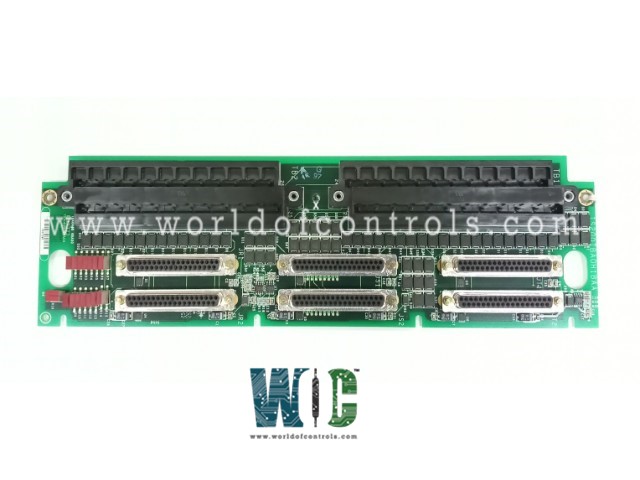SPECIFICATIONS
Part No.: IS200TBAOH1BAA
Manufacturer: General Electric
Country of Manufacture: United States of America (USA)
Size: 10.16 cm wide x 33.02 cm high
Temperature: -30 to +65 oC
Number of channels: 16
Product Type: analog output terminal board
Availability: In Stock
Series: Mark VI
Functional Description
IS200TBAOH1BAA is an analog output terminal board developed by GE. It is part of the Mark VI series. The analog output terminal board (TBAO) supports 16 analog outputs with a current range of 0-20 mA. These outputs transmitts control signals to various components within the system. Its design features, including terminal blocks and connectors, ensure seamless integration and efficient operation within the control environment.
Features
- Current outputs are generated by the I/O processor, which can operate either locally (Mark VIe) or remotely (Mark VI). This flexibility allows for seamless integration with different generations of control systems.
- To ensure reliable and accurate signal transmission, current outputs from the TBAO are equipped with noise suppression circuitry. These circuits protect against surge and high-frequency noise, maintaining signal integrity even in challenging operating environments.
- Features two barrier-type terminal blocks for customer wiring, providing a convenient interface for connecting external devices or subsystems. Additionally, it includes six D-type cable connectors, facilitating easy integration with other system components.
- The analog output current range of the terminal board spans from 0 to 20 mA, providing a versatile signal output capability crucial for various control and monitoring applications.
Installation
- Mounting: The terminal board is affixed to a vertical mounting plate, providing stability and support during operation.
- Wiring Analog Outputs: The 16 analog outputs are directly wired to two I/O terminal blocks situated on the left side of the board. Each terminal block accommodates two 3.0 mm (#12AWG) wires with 300 V insulation per point, using spade or ring type lugs. Two screws secure each terminal block in place, ensuring a secure connection. Adjacent to each terminal block, a shield terminal strip is attached to chassis ground, enhancing electrical safety and performance.
- Cable Connections: In Mark VI systems, cables with molded plugs establish connections between the D-type connectors and the VME rack housing the VAOC processor. For simplex configurations, two cables are utilized, while six cables are employed for TMR setups. In Mark VIe systems, PAOC I/O packs are directly plugged into designated D-type connectors on the board. Special side mounting brackets support the PAOC I/O packs, ensuring secure attachment and optimal functionality.
Diagnostics
- Voltage Drop Measurement: The terminal board has a mechanism to measure the voltage drop across a series resistor, which helps monitor the output current. By measuring this voltage drop, the system can detect if the current is within the acceptable range. If the output current deviates from expected values, the I/O processor generates a diagnostic alarm or fault. This alarm indicates that one of the two outputs is malfunctioning or has become unhealthy, prompting further investigation.
- Cable Connector ID Verification: Each cable connector on the terminal board is equipped with a unique ID device, which holds critical information about the connector. This ID device is a read-only chip and stores details such as Serial number of the terminal board, Board type (identifying what kind of terminal board it is), Revision number (to track updates or modifications), and Connector locations (JR, JS, JT) that specify which connectors are in use. The I/O controller routinely interrogates the ID device to retrieve and verify this information.
- Fault Detection for Hardware Incompatibility: During ID device interrogation, the I/O controller checks for any mismatch between the information read from the chip and the expected hardware setup. If any discrepancies are found such as the wrong type of terminal board, incorrect connector locations, or mismatched revision numbers a hardware incompatibility fault is triggered. This diagnostic helps ensure that the correct hardware components are used together, preventing system malfunctions due to incompatible parts.
The WOC team is always available to help you with your Mark VI requirements. For more information, please contact WOC.
Frequently Asked Questions
What is IS200TBAOH1BAA?
It is an analog output terminal board developed by GE under the Mark VI series.
What is the maximum current output range supported by the terminal board?
The board supports an analog output current range from 0 to 20 mA, providing flexibility for various control and monitoring applications.
How does the board handle customer load resistance?
Depending on the configuration, the TBAO terminal board can accommodate different burdens. It supports up to 500 ohm burden with certain configurations and up to 900 ohm burden with others, ensuring compatibility with diverse load resistance requirements.
How does the board indicate output current status and health?
The board utilizes a series resistor to measure the voltage drop across it, providing an indication of the output current. Additionally, the I/O processor generates diagnostic alarms if any output becomes unhealthy, ensuring timely detection of issues.
What role does the ID device on each cable connector play?
Each cable connector on the terminal board features an ID device containing essential information such as the board serial number, type, revision number, and connector location. This information ensures proper configuration and compatibility, reducing the risk of hardware incompatibility faults.
How does the board contribute to system reliability and integrity?
By providing accurate analog output signals and implementing diagnostic features, the terminal board enhances system reliability and integrity. The board's ability to detect faults and ensure compatibility with other components minimizes the risk of errors and promotes smooth operation within control systems.
